Bls recertification Study guides, Class notes & Summaries
Looking for the best study guides, study notes and summaries about Bls recertification? On this page you'll find 66 study documents about Bls recertification.
All 66 results
Sort by
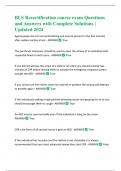
-
BLS Recertification course exam Questions and Answers with Complete Solutions | Updated 2024
- Exam (elaborations) • 4 pages • 2024
- Available in package deal
-
- $10.49
- + learn more
BLS Recertification course exam Questions and Answers with Complete Solutions | Updated 2024
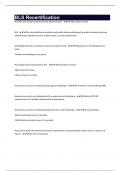
-
BLS Recertification
- Exam (elaborations) • 5 pages • 2024
-
- $10.49
- + learn more
At what rate should compressions be administered? - 100-120 per minute BLS - the care healthcare providers and public safety professionals provide to patients who are experiencing respiratory arrest, cardiac arrest, or airway obstruction Distinguish between respiratory arrest and cardiac arrest - Respiratory-no breathing but has pulse Cardiac-no breathing and no pulse How deep should compressions be? - Adult-at least 2 inches Child-around 2 inches Infant-around 1.5 inches How do you car...
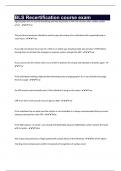
-
BLS Recertification course exam
- Exam (elaborations) • 3 pages • 2024
-
- $7.99
- + learn more
Agonal gasps are not normal breathing and may be present in the first minutes after sudden cardiac arrest - True The jaw thrust maneuver should be used to open the airway of an individual with suspected head or neck injury - True If you did not witness the arrest of a child or an infant you should provide two minutes of CPR before leaving them to activate the emergency response system and get the AED - True If you cannot see the infants chest rise and fall re-position the airway and attemp...
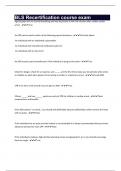
-
BLS Recertification course exam
- Exam (elaborations) • 3 pages • 2024
-
- $7.99
- + learn more
Agonal gasps are not normal breathing and may be present in the first minutes after sudden cardiac arrest - True An AED can be used in which of the following special situations - All of the above An individual with an implanted a pacemaker An individual with transdermal medication patch on An individual with a hairy chest An AED may be used normally even if the individual is lying on the snow - True Check for danger, check for a response, and _____ are the first three steps you should tak...
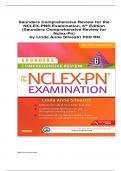
-
Saunders Comprehensive Review for the NCLEX-PN® Examination, 5e (Saunders Comprehensive Review for Nclex-Pn) by Linda Anne Silvestri PhD RN.
- Exam (elaborations) • 401 pages • 2023
-
- $28.99
- + learn more
A client is scheduled to receive acetylcysteine 20% solution diluted in 0.9% normal saline by nebulizer. Which outcome would the nurse expect as a result of the administration of this medication? Thinning of respiratory secretions A client has begun therapy with a xanthine bronchodilator. The nurse determines that the client understands dietary alterations if the client states to limit which items while taking this medication? Select all that apply. Coffee Chocolate The nurse is per...

-
BLS Instructor /Red Cross Instructor Exam Package Deal -Solved
- Package deal • 5 items • 2023
-
- $15.99
- + learn more
BLS Instructor 2023/24 Exam Graded A+ ICT BLS INSTRUCTOR 2023/24 EXAM BLS instructor Questions and Answers Red Cross Instructor Test Latest Updated Basic Life Support for Healthcare Providers Instructor/IT Recertification Assessment Latest Updated
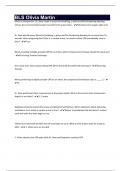
-
BLS Recertification course exam 100% Passed
- Exam (elaborations) • 2 pages • 2024
-
- $2.99
- + learn more
Olivia is unresponsive. Dr. Dave needs to assess for breathing, a pulse and life-threatening bleeding. Choose the recommended location to perform the pulse check. - Brachial artery (upper right arm) Dr. Dave should assess Olivia for breathing, a pulse and life-threatening bleeding for no more than 10 seconds. After recognizing that Olivia is in cardiac arrest, he should initiate CPR immediately, true or false? - True When providing multiple-provider CPR for an infant, which compression tech...
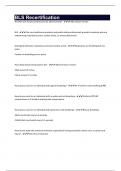
-
BLS Recertification
- Exam (elaborations) • 5 pages • 2024
-
- $10.99
- + learn more
At what rate should compressions be administered? - 100-120 per minute BLS - the care healthcare providers and public safety professionals provide to patients who are experiencing respiratory arrest, cardiac arrest, or airway obstruction Distinguish between respiratory arrest and cardiac arrest - Respiratory-no breathing but has pulse Cardiac-no breathing and no pulse How deep should compressions be? - Adult-at least 2 inches Child-around 2 inches Infant-around 1.5 inches How do you car...
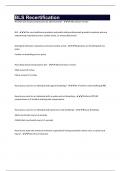
-
BLS Recertification
- Exam (elaborations) • 5 pages • 2024
- Available in package deal
-
- $7.99
- + learn more
At what rate should compressions be administered? - 100-120 per minute BLS - the care healthcare providers and public safety professionals provide to patients who are experiencing respiratory arrest, cardiac arrest, or airway obstruction Distinguish between respiratory arrest and cardiac arrest - Respiratory-no breathing but has pulse Cardiac-no breathing and no pulse How deep should compressions be? - Adult-at least 2 inches Child-around 2 inches Infant-around 1.5 inches How do you car...
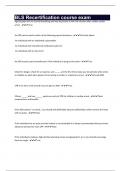
-
BLS Recertification course exam
- Exam (elaborations) • 3 pages • 2024
-
- $12.99
- + learn more
Agonal gasps are not normal breathing and may be present in the first minutes after sudden cardiac arrest - True An AED can be used in which of the following special situations - All of the above An individual with an implanted a pacemaker An individual with transdermal medication patch on An individual with a hairy chest An AED may be used normally even if the individual is lying on the snow - True Check for danger, check for a response, and _____ are the first three steps you should tak...

Study stress? For sellers on Stuvia, these are actually golden times. KA-CHING! Earn from your study resources too and start uploading now. Discover all about earning on Stuvia


